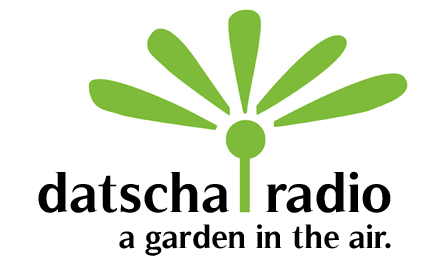
The weather was changeable and rainy on the last day of June. The puddles on the paths to the garden colony “Einheit” were so deep that we really should have arrived with rubber boots. Instead, we traveled with self-tailored dresses in the style of the 1920s. Because as part of the Long Night of Museums in Altenburg, the motto of the festival in the Historic Laubengarten focused on the founding year of the colony: “A Day in June 1923”.

The small wooden bower, which Datscha Radio used as a studio because of the rain, was not only decorated with porcelain, original table linen, and a brass hanging lamp but also with an old so-called Volksempfänger. It is quite possible that people were already listening to the radio in the allotment gardens back then because 1923 was also the year of the first radio broadcast in Germany.

In order to test the planned VHF transmission in August from the Laubengarten despite the adverse weather, our mini transmitter was mounted on a spruce branch a good four meters long. Frank Vohla, the tenant of the neighbouring Sternengarten (Garden of Stars) and amateur astronomer, came to our aid. The Sternengarten is also a project of the association: a telescope mounted under the attic window will allow future guests to make astronomical observations there.
The rain, however, turned out to be the lesser problem. More problematic was the failure of the telecommunications provider. While we feverishly searched for a solution and found it after some time, the garden and the buffet filled up. Almost every visitor brought a tray with cakes and canapés or drinks for the buffet. The redcurrants were clearly in season.


At 7 pm, we went on air tentatively with a conversation with the volunteer organizer of the festival and chairperson of the Historic Bower Garden Association, Grit Martinez.
She gave us an insight into the development of the foliage colony over the last 40 years. Would the gardens have all been occupied before the fall of the Wall? Here Ms. Martinez answered with a resounding Yes! Before that, there had been a good 60,000 inhabitants in the city, but in the course of the 1990s, there were soon only about 30,000. Not only the young, but whole families left for the West. There are still 66 deciduous colonies in Altenburg, but only just under a third of them are cultivated. While in Berlin and actually in all (West) German cities people have to sign up for long waiting lists for an allotment garden, just three years ago a good 70 unity gardens stood overgrown. The restoration of the Historische Laube and the work of the association led to a reactivation of the abandoned plots as well, of which a good 40 have now been mediated.

Meanwhile, Helen Thein was out and about in the neighbouring gardens to capture the voices of the gardeners: Conversations and walks in front of and behind the garden fences, which in the Einheit e. V. (in contrast to some other allotment garden colonies) are not measured out super-strictly to their 1.20 m with a string.
The interest in nature-friendly gardening is huge and is supported by young and old alike… at least in this colony. Many gardens were and are cultivated by several generations, for example, Mrs. Martinez’s great-grandparents were already working on the same allotment where her parents are currently gardening.

The shellac record collection, which was the musical centerpiece of the entertainment, also came from their estate. A new guest strode through the garden gate and attracted attention: a young man, meticulously dressed in the style of the 1920s. Naturally, we asked for a radio appointment…

8:15 pm was the time for the ‘official radio talk’ with Ms. Martinez and the association’s vice-chair, Christine Junk. Together we looked back at the history of the deciduous gardens and discussed the relevance of subsistence farming today. Ms. Junk, who had taken over the planting of the Historical Deciduous Garden, spoke about the preservation of old fruit and vegetable varieties – also with an eye on climate change, which challenges us to experiment with new species and seeds. Both emphasized the cultural tolerance and openness of their association as the most important feature. Several Ukrainian families have found a new garden home here. What, if not openness and diversity, should make successful gardening possible?

In the next radio talk, we also learned the name of the young man dressed so smartly in knickerbockers and a slouch hat. Matteo had become aware of the theme of the garden festival through the ‘Museumsnacht’ poster. It was a rare opportunity to learn first-hand what makes the magic of the 1920s for young people today… and it became clear that it is not easy to afford clothes and ambience away from the big cities.
Gradually, more and more guests in a celebratory mood streamed through the gate into the Historic Bower Garden. Many came to the bower and peeked in to see what our radio looked like.

Finally, Helen and I looked ahead to our plans for future broadcasts. Datscha Radio returns to the Laubengarten in the first week of August and will lend its eyes and ears to the diverse (wild) gardens of the city, the presence of gardening, and its actors in Altenburg. The ‘Streuobstradio’ in early autumn, on the other hand, will speculate on new seeds and forms of gardening togetherness. We are looking forward to it!
Read More